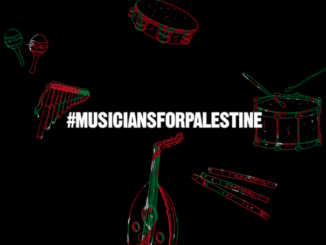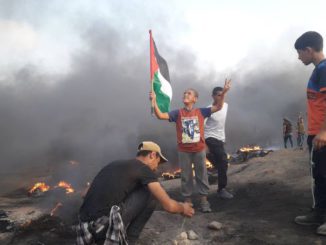
By David Harrop
On my first night in Palestine in Nablus in 2011, I sat transfixed as I watched a Dabke troupe of Palestinian youth leap and dance with pride in their culture and defiance in their spirit.
Dancing to music; what could be more joyful? Rhythm and sweat release and abandon, feeling rather than thinking. Dancing can give you a fleeting glimpse of freedom. Dance can be resistance both as a ritual and contagious with unruly energy.
Last year, I was in the West Bank and undertook a series of interviews with social work colleagues. As a UK Social work practitioner, I am particularly interested in the modes of locality-based social work that have emerged from the years of struggle.
This is a radical form of social work based in the refugee camps, which has emerged from the streets and can be seen as grassroots practice or barefoot social work.
This is anti-bureaucratic practice, which is radical, political, and based on the tradition of social pedagogy of Paulo Freire, where workers and volunteers work in ways that are politically informed and seek to provide platforms for education and self-expression. (Pedagogy of the Oppressed 1968)
Much of their activity is occupied with seeking to create and enable platforms for youth to explore the narratives of their lives and their creative potential to articulate their experiences.
Whilst recognizing the roots of culture it is not about reclaiming ancient culture as much as looking at producing new work which seeks to contest and reflect the current experiences of oppression. This is with the precise desire that their work would be unique and come from themselves with the potential to create new social and political relationships.
The colonized setting for this music/film/artwork/fashion remains poignant and ever-disturbing, as youth contemplate their present and future from within the context of the trauma of 75 years of oppression.
How can social workers help to support youth to find ways to self-expression and where are the times and spaces where we can do this? What is the role of social animators who can provide platforms and the necessary mentoring / enabling resources?
What are the tensions around this expression, the aesthetic, and the political context? How can this shape and lead the national discourse and burnish and stoke the engine rooms of resistance across Palestine and the diasporas?
At one point, I met with the author of a study into the youth of Dheisheh refugee camp during the first intifada. Through the course of our discussions, she told me about her brother the late musician Riad Awwad who was renowned amongst the resistance during the first intifadas.
He made music of the Intifada sometimes using the poetry of great Palestinian writers which resonated highly and was played in cafes and businesses. The tapes were frequently confiscated by the Israelis as they were believed to incite violent resistance.
Riad was arrested and subjected to torture, although never actually charged. His work has recently been re-released on the UK-based Majazz project label which seeks to preserve the Palestinian musical heritage along with newer trance, dancehall, and techno music as well as Bedouin psychedelia.
Whilst I was in the West Bank, I was able to interview youth and project leaders from street-based projects in Dheisheh and Aida refugee camps who were engaged in street-based activities.
One person explained to me that how as a child she had become so utterly traumatized by the violence in Dheisheh she temporarily lost the capacity of speech. Through engagement with the Ibda Centre youth group, she joined a Dabke dance troupe, and through immersing herself in music and movement she was able to move out of her traumatized state and is now a successful filmmaker with an international reputation.
Another Social worker from Aida camp describes his despair when 10-year-old children tell him that they don’t want to live anymore and just want to die.
Another evening I sat tearfully with a dear social worker friend as she and I watched a troupe of young children with hearing disabilities dance the Dabke in the ruins of a half-built house in Doha.
Another colleague who is trained in theatre work and puppetry seeks to engage people in artistic activities and says that all resistance is a beautiful activity, and he is a proponent of all activities as beautiful resistance.
Another project in Dheisheh explained how they were seeking to empower young women through art and how a group was really committed to wanting to create a rap tune. Seemingly this went viral when it went online, and they believe these examples help to shift boundaries of gender perceptions, becoming potential sources of emancipation.
Resistance can take many subtle and not-so-subtle forms. Apart from active protest and physical confrontations, there are many forms of protest taking place through reportage and critical creative activity which embody and articulate the experience of resistance through finding a voice and seeking to ignite the imaginations of others.
All these initiatives are concerned with how lives can best be led whilst in the context of occupation, and in providing such platforms create spaces for narratives that give voice and are empowering. Another youth commented that rates of depression and futility are very high. Any activities that allow space for self-expression are protective and build resilience being protective against mental health risks.
Whilst contemporary Palestinian culture has many dimensions, arguably there is a core aesthetic around the principles of building and articulating resistance. The DNA manifests itself through the ethno-fusion of traditional and modern.
There are bands such as 47Soul who have taken the sensibilities of the Dabke into the 21st century with the Sham step movement made for blasting out high-energy electronic dance music out of cafes and car radios and encouraging youth to congregate around sound systems.
Many young Palestinians who are inspired by the techno scene appear to harbor a strong desire to relocate to Berlin where they feel that they could immerse themselves in the culture of film music art etc. whilst taking their Palestinian DNA with them.
There were recent outpourings of grief following the untimely death of Palestinian techno DJ and producer Odai Masri who championed music as a means of solidarity and resistance. He pioneered the annual EXIST festival, which seeks to forge links of solidarity between Palestine’s fiercely creative artistic community and their global counterparts based between Ramallah and Berlin.
Its broad, transnational family are united in a desire to use art to impact their environments in critical ways, and through their engagement with anti-colonialism in the context of Palestine and beyond.

– David Harrop is an independent UK-registered social worker and co-founder of Palestine UK Social Work Network (PALUK) in 2011. Contact the author at his address email: harrop_david@yahoo.co.uk. He contributed this article to The Palestine Chronicle.







